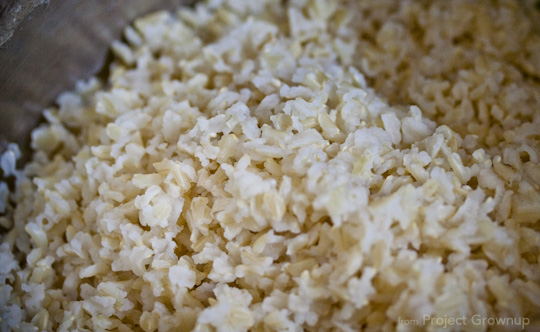 Last week: Beans. This week: Rice. Sounds like the first year of my marriage.
Last week: Beans. This week: Rice. Sounds like the first year of my marriage.
But seriously. Rice is remarkably easy to do. So why do we just continue to use boil-in-bag (which serves, what, one sixteen-year-old?) instead of making it from scratch?
For many years I avoided rice because I wouldn’t remember how long it took to cook, or thought I’d burn it, or just didn’t want to bother. Even after I felt confident with white rice, I still shied away from cooking brown rice (which I prefer) because I wasn’t sure I would cook it all the way or didn’t want to wait forever.
Actually, I don’t know if it was any of that at all. But for some phantom reason, I never wanted to bother with rice.
Then one day I discovered Saveur‘s technique for “perfect brown rice”. Though it had rice and water amounts listed, I quickly realized there was no real need to measure either of them. And with the technique having a degree of difficulty on par with boiling noodles, I knew the rice preparation could go on in the background while I prepared the rest of dinner. Without me having to fuss with it. That’s a win, my friends. But would it work?
I’m happy to say that it does. And elated to share it with you!
 Saveur’s Brown Rice Method (Boil It!)
Saveur’s Brown Rice Method (Boil It!)
This is stupid easy, you guys. If you make rice, you’ve gotta try it.
You’re going to need a pot, some water, and some brown rice. Simple, right?
- Put a generous amount of water in the pot and boil it. Saveur says to use 12 cups. I can’t be troubled to measure. So I fill my large-ish pot 2/3 full. It’s fine.
- Rinse brown rice in colander or sieve. Just give it a good rinse. Use however much you want. If you’re feeding a family of four, first time around, think “about a cup”. If you want more, make more. I’m telling you, this method is awesome. No need to overthink it.
- Once water is boiling, add the rice. Set a timer for 30 minutes. (Leave the pot uncovered.)
- When the timer goes off, drain the rice. Let it sit for 10 seconds or so in the colander and then…
- Put it back in the pot and cover with a tight-fitting lid. (The steam is going to finish cooking the rice.) Set your timer for 10 minutes.
- When the timer goes off, you’re done. Ta-da!
Quick Recap
Boil some water. Add some rice. Drain after 30 minutes. Return to pot for some additional steaming.
And that’s how you make brown rice without measuring!
…so…
Think you’ll try it?
